The Harappan Civilisation is divided briefly in three phases; the Early Phase 3500 BC – 2600 BC the Medium Phase 2600 BC – 2000 BC and the Late Phase 2000 BC – 1500 BC. The harappan Civilisation grew in India step by step in time and space from the village stage to the township stage and finally to the city stage. After 2000 BC declined and in By 1500 BC cities were replaced by villages.
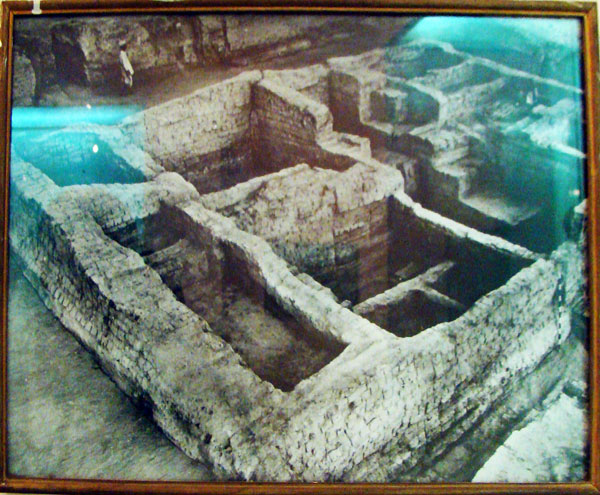
model of house of Harappan civilisation, more than 500 years from now in the 4th millennium BC, some people from
the foothills of baluchistan, started moving into the river valley of
Indus and Saraswati. One group reached the costal region and setteled
down at sites like Balakot, and one group reached the Punjab and North
west rajasthan and setteled down in cities like Harappa and Kuchanwala.
Slowly and gradually these people evolved a civilization called Harappan
Civilisation (Civilization); the Indus Civilisation (Civilization); the
Indus Valley Civilisation (Civilization) and the Indus Saraswati Civilisation
(Civilization)., Which was contemporary Egyptian and Mesopotamia civilization
but the different from both of them.
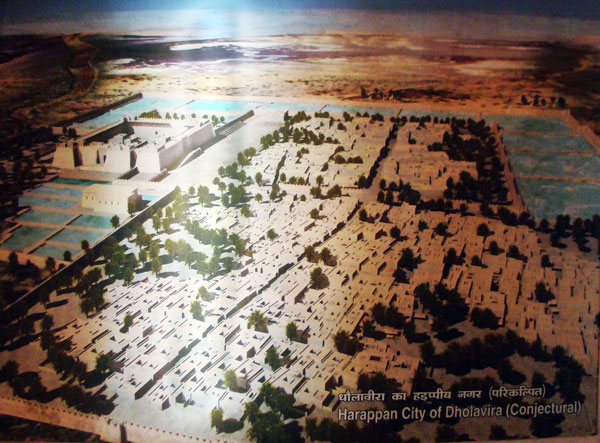
3D model of Indus valley civilisation, Dholavira
Archaeologies have so far located around 1400 sites of this civilization
in India and Pakistan together. Of these around two dozen very important
sites have been excavated. Harappa on the river Ravi was excavated by
Daya Ram Sahni, MS, Sir Wheeler, and Richard Meadow and J Kenoyer. This
is all started from 1921 – 1922 first Harappa was dug, then a year later
Mohanjodaro.
After the partition of India 1n 1947, Indian scholars worked hard and
excavated several important sites in India such as Lothal by SR Rao, Kalibangan
by BB Lal and BK Thapar, Banawal and Dholavira by RS Bisht. The dried-up
course of the Vedic and Saraswati was explained A Ghosh and MR Mughal
both in India nad Pakistan yielding the evidence of more than 500 sites,
explorations in the Indus Valley however located nearly around 150 sites.
It is now clear that the Harappan Civilization was the gift of two rivers,
the Indus and the Saraswati, however the harappan sites are also located
beyond the basins of Gajner, Sindh part of Baluchi hills and western Uttar
Pradesh. It has an area around 1600 km from the north to south and around
the same area from the east to the west which is more than twice the combined
territories covered by the Mesopotamia and Egyptian civilizations.
The city of Dholavira was in the form of a parallelogram guarded by a fortification. The area measuring 771 meters in length and 616.80 meters in which enclosed several principal divisions, i.e. the citadel, the middle town, the lower town, the ceremonial ground and a series of water reservations all-round the city. The citadel stood majestically on the south, consisting of two fortified divisions, the castle, in the east and bailey, in the west. The middle town, also fortified, lied to the north and is separated from the citadel by a long and wide ceremonial ground. The lower town was laid out within the general fortification to the east of the middle town. In the citadel area, a network of drains, both small and the large was discovered
Area of upper town meant for high class and the other, the lower town meant for the common men. Within the ‘Lower Town’ there were many sectors for specialized crafts, for shops and bazaars for social gatherings etc. The ‘citadel’ is usually marked by a series of platforms, with fire altars at Kalibangan, the great Bath at Mohenjodaro, ‘Warehouse’ at Lothal and Granaries at Harappa and Mohehjodaro; and public buildings such as the Pillared Halls at Mohenjodaro and Dholavira, rungashala or stadium at Dholavira, and special purpose structures, such as the ‘Dockyard’ at Lothal.
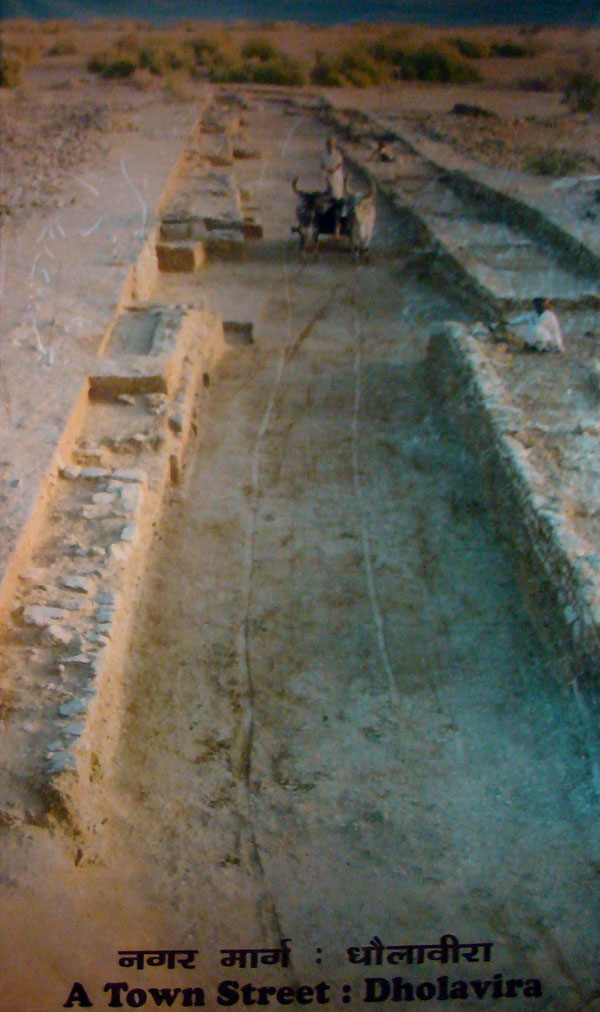 The harappan cities are known for the near roads and lanes, usually crossing
each other at right angles, creating on chessboard pattern blocks of houses,
some with open courtyard, furnished toilets, kitchens, living rooms, and a few with stairecase leading to roof terrace or upper storey. Mostly
the Harappan settlements are secured by defensive walls with salient and
gateways.
The harappan cities are known for the near roads and lanes, usually crossing
each other at right angles, creating on chessboard pattern blocks of houses,
some with open courtyard, furnished toilets, kitchens, living rooms, and a few with stairecase leading to roof terrace or upper storey. Mostly
the Harappan settlements are secured by defensive walls with salient and
gateways.
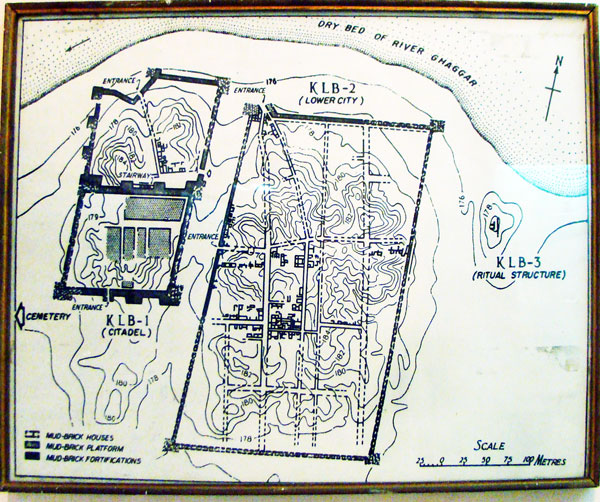
Plan of Indus valley civilisation
The Harrapan culture was a Bronze Age culture, yielding all type of artifacts of copper and bronze, ornaments and jewellery of gold, silver and semi-precious stones, seal and sealings of steatite and other materials depecting bulls, elephants, unicorns, tigers, crocodiles, and several other animals besides narrative scenes on various themes, including hunting, worshipping and unknown mythologies. Seals with deities wearing horned tiaras and sitting in yogic posture, men in formal dresses with peaked caps, papal leaves, swastika, cross, ets appear to reflect legends and belief systems the details of which are not known to us since although most of them bear short inscriptions in a well established script, still the script, written from the left to right, has as yet not been deciphered to the satisfaction of the scholarly world.
The art of the Harrappans is manifested in a variety of ways, besides the intaglio and glyptic art of the seals, For example, the bronze which include the famous ‘Dancing Girl’ and sensitively modeled Buffalo from Mohenjodaro, red stone male torso and black stone dancer from Harappa. The so-called ‘Priest’ and Male Head from mohenjodaro, and a number of ivory, shell and faience figurines of men and animals from various sites terracotta Mother Goddess and bulls from Chanhudaro, Mohenjodaro, Harappa and Kalibangan, To these may be added a sculpture of a mongoose or monitor lizard and a large through mutilated stone icon of a nude male diety from Dholavira, Kalibangan has yielded a terracotta modal of Shiva-linga in yoni-pitba.
 Harappan Civilization
Harappan Civilization
The Harappan are also known for their long-distance trade with the cities of Mesopotamia, Failaka, Behrain, Oman ets. Through the Persian Gulf. The overland trade-routes. Passing through Afghanistan and Turkmenistan, also connected the Harappan cities with the cities of other contemporary civilizations.
In recent years, the excavations at Dholavira have yielded the evidence of a unique system of water management in an extremely dry region of Rann of Kachchh-cutting down bedrock to create huge tanks with steps. At Kalibangan there are the remains of a plaughed field, so far the oldest known example of its kind, where two crops were grown together. The dockyard of Lothal, so far the world’s earliest known dock, exported various items to West Asia.
The Harappan people disposed of their dead by burying them in pits and pots as well as cremated them. There is the evidence of fire-worship at lothal, Banawali, Kalibangan, ets. There is also the evidence of an oval mud-brick structure with fire-altars at Banawali. Surkotada has yielded the bones of true domesticated horse (Equus Labalus Linn)
Only a few years back gold and silver jewellery, including a tiara and as armlet, was discovered at Kunal, a small Early Harappan site in district Hissar, Haryana. However, the bulk of the excavated material at the Harappan sites is always the beautifully decorated pottery with black paintings over bright red background. The motifs include geometric designs as well as fauna and flora. Further, several boards of exquisite finds of the Harappan lineage have been found at quite a few sites of late Harrapan phase. Four exquisite bronzes, comprising a bull drawn chariot with its driver, a rhinoceros, an elephant and a buffalo, were found at Daimabad, district Ahmednagar, Maharashtra. Jewellery and other objects have come from Nagwada, district Surendranagar, Gujarat. And now a very large hoard of jewellery of gold, silver and semi precious stones with two copper container has come to light at Mandi in district Muzaffar Nagar – western UP
Lothal (Distt. Ahmedabad, Gujaratt):
Mud brick house, mud bricks platform, mud brick fortification
The settlement was rectangular of plan and consisted of two parts, the citadel and the lower town, The former on the south-western part, was distinguished by its eminence since it was built upon mud-brick platform. Of the structures exposed within the citadel, the warehouse, built on high podium with blocks of mud-bricks, is unique, Baked and twisted clay sealing of normal Harappan type, presumably fallen from the burnt stored bales of goods, had been recovered from the air ducts between the blocks. The lowers town contained, apart from the residential sector, the market as also the industrial area. The most individualistic structure was an along dock (214 X 36 m) with necessary gap for a sluice gate, inlet, etc. The find of a circular seal of Persian Gulf type, picked op from the surface, perhaps pints to the existence of maritime trade with West Asia. The other finds include a number of seals, chart blades and fish-hooks of copper and bronze.
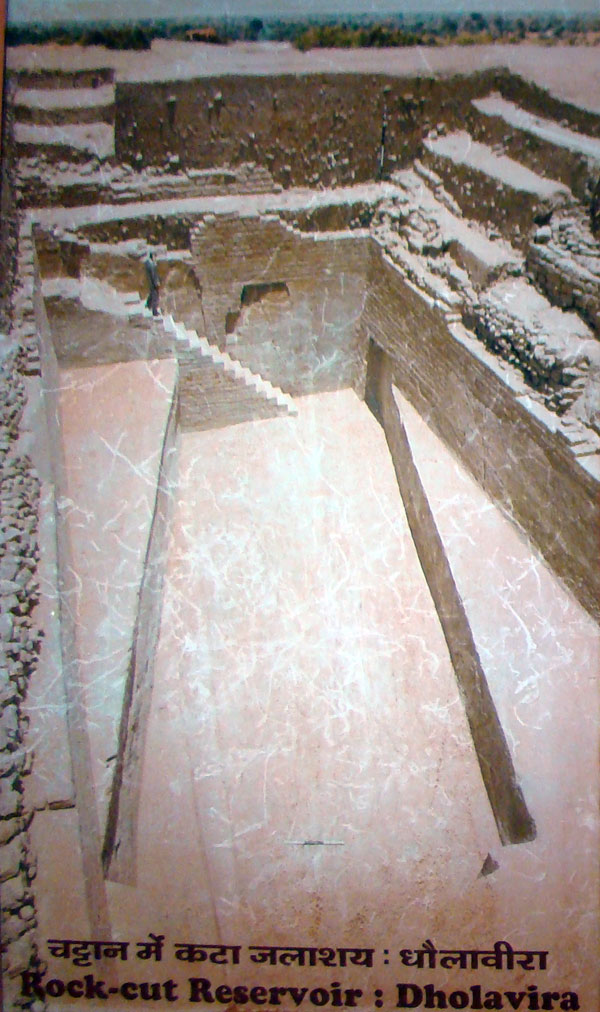
Dholavira (Distt. Kachchh, Gujarat): Dholavira has emerged as one amongst the five great urban center of the Harappan Civlisation. The excavation have indicated that there lies buried spectacular remains of a Harappan city which is highlighted by its enormous proportions, its intricate planning delineated by an elaborate fortification system, perfect architecture, fine water management system and huge cultural accumulation. It has also provided ample indication that the Harappan Civilization had not only lived its full life at Dholavira but was also preceded by formative stages and followed by impoverished successors. Besides, the site will always be remembered for yielding a signboard inscription consisting of ten large Harappan characters, a unique discovery indeed.
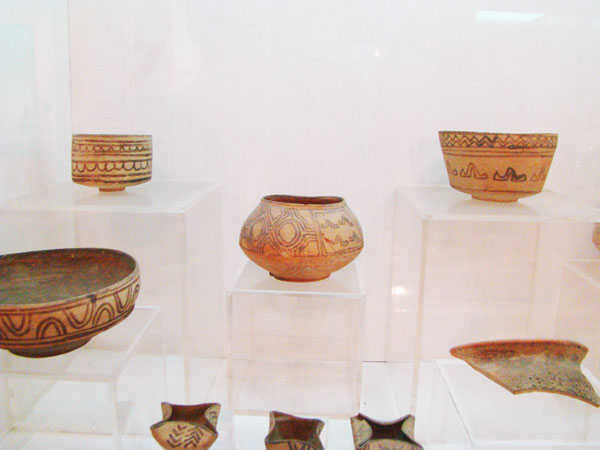
Clay pot of Harappan civiliation, Indus valley civilisation